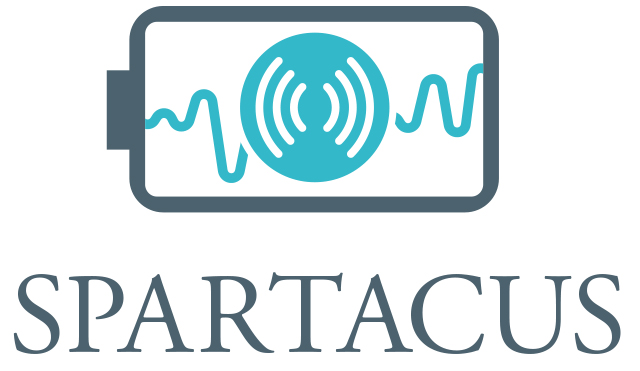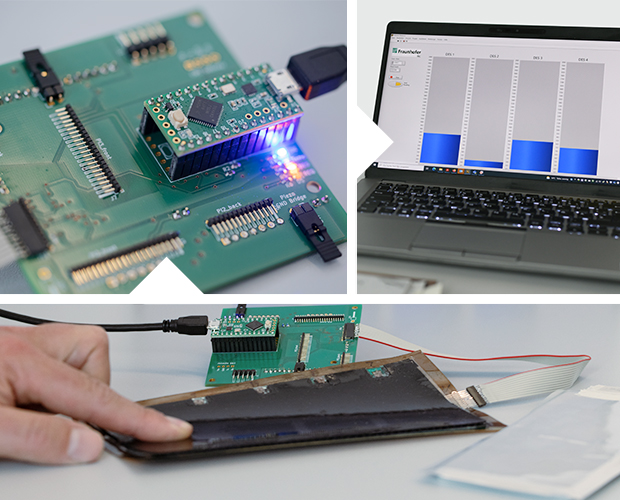Smart sensors for future fast charging – "SPARTACUS" battery research project has mastered the first milestones


The SPARTACUS research project as part of the EU research initiative BATTERY 2030+ has now been running for around a year. The project has successfully mastered the first milestones and project goals. On the way to sensor-based optimization of charging times, range and service life for lithium-ion batteries, the SPARTACUS project team has worked on a number of partial aspects over the past 12 months. Now the individual components can be combined into a complete system.
SPARTACUS - the abbreviation stands for "Spatially resolved acoustic, mechanical and ultrasonic sensing for smart batteries". The research project aims to develop a multifunctional sensor array technology for batteries that transmits the relevant data to the battery management systems for optimal charging and discharging depending on the battery condition. The project focuses on mechanical and acoustic sensors, supplemented by electrochemical impedance measurements and temperature sensors. The SPARTACUS sensor technology is intended to detect faults and negative influences on battery life and performance at an early stage.
The SPARTACUS project team started its work one year ago. The goal is to ensure that previously unused reserves in battery management are exploited in the future by means of comprehensive battery monitoring. This should make it possible to reduce charging times by up to 20 % without compromising reliability and service life. "The SPARTACUS project has broken new ground in many respects," explains coordinator Gerhard Domann of Fraunhofer Institute for Silicate Research ISC. For example, he says, not only have new sensor concepts been prepared by combining acoustic-mechanical and thermal sensors with advanced analysis methods, but the modeling of the processes in the battery cell has also been advanced in such a way that new prediction models for battery condition and optimal charge control are possible. "After the first year of the project, all working groups have successfully advanced their individual project work, and all specifications have been defined. Now it is a matter of putting the puzzle pieces together and linking them into a successful monitoring technology for batteries," Domann continues.
This marks the beginning of the second project phase, in which the new battery sensor technology will deliver real data in precisely defined test series, which will be correlated with the model data. On this basis, the refined prediction models will be developed, with which future battery management systems can better exploit the performance range of the batteries. At the Green Batteries Conference 2021, which took place in October, the first project results were already presented to a larger audience from science and industry and received with great interest.
The SPARTACUS work packages
Specifications
With the first work package, the specification protocols were defined on different levels, starting with the sensor, data pre-processing, integration, modules, battery management systems, validation and the LCA methodology framework. The work package has already been completed and forms the basis for the collaborative development within the SPARTACUS project.
Sensor development
The aim of the sensor development work package is to develop new integrated multi-sensor technologies for monitoring the operating state of battery cells in terms of electrical, mechanical and thermal parameters. If possible, the sensors should provide information with local resolution.
The sensor technologies include
- Various ultrasound procedures
- Flexible capacitive stress, strain and pressure sensor arrays
- Temperature sensors
- Impedance spectroscopic measurements
Assembly and interconnection technology
The integration and assembly technology work package is closely linked to the sensor development work package. In addition to primary integration and assembly, signal evaluation and data acquisition as well as data preprocessing are also challenging tasks. For the assembly, different sensor levels must be combined into one system without loss of sensitivity for the different sensors.
Modelling
The modelling work package aims at obtaining a complete monitoring and control of the battery system to increase its quality, reliability and lifetime (QRL) and to ensure its operation within a predefined safe operating area (SoA). In this context, the states of the batteries should be systematically extracted and validated. The sensor signals should be correlated with the different fault mechanisms. Methods based on artificial intelligence will also be used to evaluate the large amounts of sensor data. The models provide the basis for controlling the cell management systems.
Cell/battery management system development
In order to exploit the advantages of intelligent sensor integration, cell and battery management systems are being adapted. The aim of the CMS/BMS work package is to develop a battery management system (BMS) that is able to read out the various sensor measurements, process the data and optimally control the cell during the charge/discharge cycles on the basis of the model calculations.
The CMS/BMS development includes
- Hardware design and production
- Software architecture, programming and implementation
- Realization of the CMS/BMS power line communication
- System level verification: a series of a few cells equipped with the CMS to achieve a 24 V system.
Ecological and economic assessment
To evaluate the environmental and economic performance of SPARTACUS smart batteries, the project includes a life cycle analysis (LCA). The increased quality, reliability and lifetime of the batteries as well as the second life and LCOES – that means levelized costs of energy storage – of extended life batteries will be assessed in accordance with the European Circular Economy Strategy and the Battery Directive. .
Validation / Demonstration
In this work package, a complex use case will be designed and set up to test all new functionalities of the SPARTACUS CMS/BMS, the new sensors and the modeling of batteries/cells in a virtual platform. This includes e.g. aging experiments under conventional CMS/BMS to compare and validate the aging behavior.
Facts about the EU project SPARTACUS
Project
„Spatially resolved acoustic, mechanical and ultrasonic sensing for smart batteries“ – SPARTACUS

Partners
- FRAUNHOFER Institute for Silicate research ISC (Coordination), Germany
- COMMISSARIAT A L ENERGIE ATOMIQUE ET AUX ENERGIES ALTERNATIVES CEA, France
- CSEM CENTRE SUISSE D'ELECTRONIQUE ET DE MICROTECHNIQUE SA - RECHERCHE ET DEVELOPPEMENT, Switzerland
- VRIJE UNIVERSITEIT BRUSSEL, Belgium
- FUNDACION CIDETEC, Spain
- ARKEMA FRANCE SA, France
- ELRINGKLINGER AG, Germany
Website
Contact
Project Coordinator
Gerhard Domann | gerhard.domann@isc.fraunhofer.de | Fraunhofer Institute for Silicate Research ISC | Würzburg, Germany
Dissemination Manager
Marie-Luise Righi | marie-luise.righi@isc.fraunhofer.de | Fraunhofer Institute for Silicate Research ISC | Würzburg, Germany